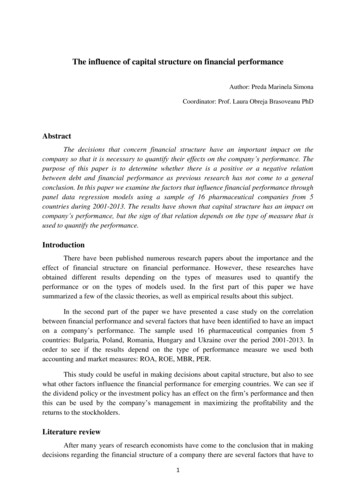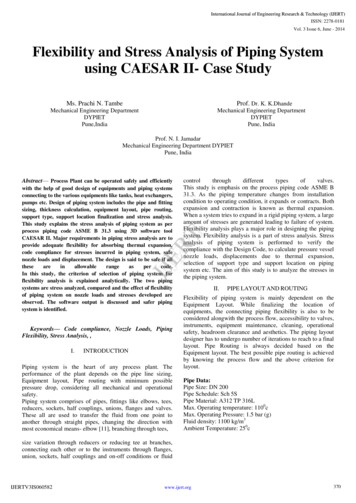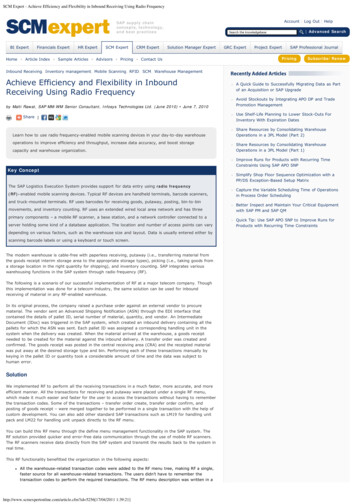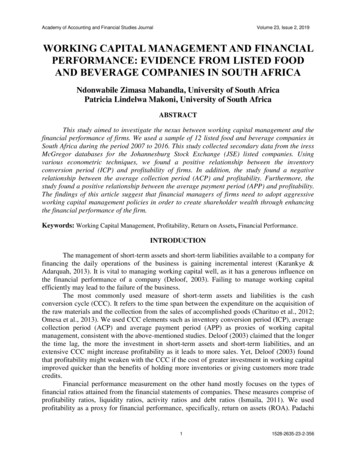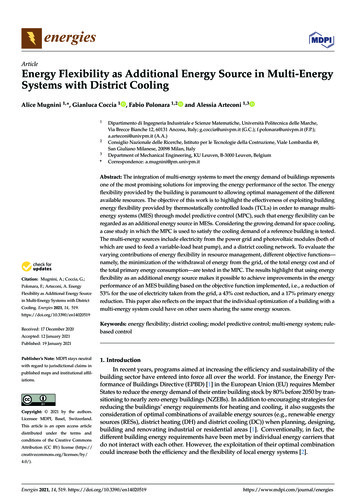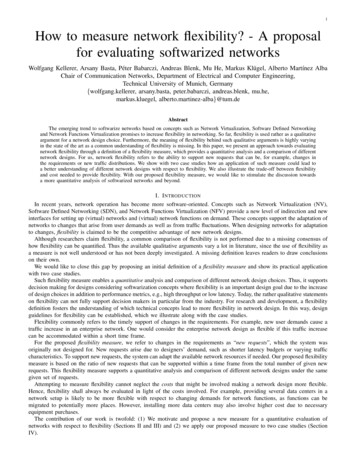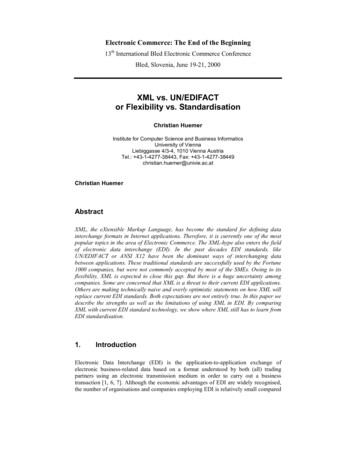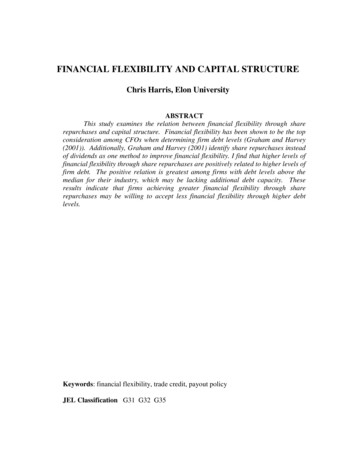
Transcription
FINANCIAL FLEXIBILITY AND CAPITAL STRUCTUREChris Harris, Elon UniversityABSTRACTThis study examines the relation between financial flexibility through sharerepurchases and capital structure. Financial flexibility has been shown to be the topconsideration among CFOs when determining firm debt levels (Graham and Harvey(2001)). Additionally, Graham and Harvey (2001) identify share repurchases insteadof dividends as one method to improve financial flexibility. I find that higher levels offinancial flexibility through share repurchases are positively related to higher levels offirm debt. The positive relation is greatest among firms with debt levels above themedian for their industry, which may be lacking additional debt capacity. Theseresults indicate that firms achieving greater financial flexibility through sharerepurchases may be willing to accept less financial flexibility through higher debtlevels.Keywords: financial flexibility, trade credit, payout policyJEL Classification G31 G32 G35
INTRODUCTIONA substantial amount of research has addressed the issue of firm capital structure and itsdeterminants. Much of the literature focuses on the trade-off theory of debt which assumes firmsdecide on a target debt level by balancing the costs of bankruptcy associated with debt againstthe tax benefits of debt [Kraus and Litzenberger (1973); Myers and Majluf (1984)] and thepecking order theory of debt (Myers and Majluf (1984)) that retained earnings are preferred todebt and that debt is preferred to issuing equity. An additional concern when issuing debt isdiscussed by Graham and Harvey (2001), which provides survey results from CFOs that showsthe number one consideration affecting the decision to issue debt is the ability to maintainfinancial flexibility. Once the firm issues debt, there is a financial commitment that removes aportion of flexibility available to the firm. Firms have a high interest in both maintaining andimproving financial flexibility [Graham and Harvey (2001); Denis (2011); Brav et al (2005)],which enhances the ability to take advantage of positive NPV projects as well as assists firms inavoiding financial distress. This study focuses on financial flexibility through share repurchases,and how it affects firm capital structure decisions. I find that greater financial flexibility inpayout policy is positively related to firms’ debt levels. Additionally, I find that this positiverelation is especially focused among firms that may be lacking additional debt capacity. Theseresults are consistent with prior research which demonstrate share repurchases as a method toimprove financial flexibility [Brav et al (2005); Bonaime et al (2014)], and identify one potentialoutcome of this improved flexibility to be an increased willingness to accept lower financialflexibility through higher debt levels.This study is significant because prior literature emphasizes both the desire for firms topossess financial flexibility and how this desire impacts individual areas of decision makingincluding capital structure [Byoun (2008); Lins et al (2010)], financial flexibility [(Guay andHarford (2000); Jagannathan, Stephens and Weisbach (2000)] and cash management policies[Opler et al (1999); Bates et al (2009)]. While this prior research has effectively identifiedflexibility’s impacts on individual areas for decision making, it has not explored how trade-offsin flexibility between these areas may occur based on the firm’s overall objectives. It may beunderstood that less debt and a higher percentage of repurchases can both result in greaterfinancial flexibility, but this paper explores whether an increase in flexibility in one of theseareas of financial decision making (payout policy) effects the firm’s decision making in the other(capital structure). This is, to my knowledge, the first paper to make such a connection.LITERATURE REVIEWDeAngelo and DeAngelo (2007) provide evidence of financial firms’ financial decisionsbeing influenced and made with the desire of maintaining financial flexibility. Empiricalevidence discusses one of these financial decisions as the tendency for managers to choose sharerepurchases as the method for paying out profits that are cyclical or derived from higher levels ofnon-operating cash flows [Guay and Harford (2000); Jagannathan, Stephens and Weisbach(2000)]. This potential flexibility from repurchases stands in contrast to the possibility ofdividends being a financial constraint that could motivate managers to reduce investments when
facing cash shortfalls (Daniel, Denis and Naveen (2010)). Using a survey of CFOs, Graham andHarvey (2001) provide further evidence that managers may favor share repurchases overdividends because the repurchases are viewed as providing greater financial flexibility. Grahamand Harvey’s (2001) analysis finds that the desire to maintain financial flexibility is one of themost important factors affecting capital structure.Capital structure refers to the level of firm financing derived from either debt or equity.When firms decide to use debt as opposed to equity, they are making the decision to receive cashup front that must then be repaid using future cash flows (Frank and Goyal (2009)). Thedecision to use debt can be problematic to firms because they are then committed to a financialobligation that may not be met if there are changes to either the economic environment or thefortunes of the firm. This explicit financial obligation could be restrictive to the firm’s growthopportunities and may reduce its financial flexibility. The question remains as to how firmsdecide what proportion of their financing should be composed on debt versus equity. Twotheories have predominantly determined the research and motivations of capital structure. Krausand Litzenberger (1973) and Myers and Majluf (1984) propose a trade-off theory of capitalstructure where firms choose the level of debt that balances the tax benefits of debt with theincreased costs of potential bankruptcy. Myers and Majluf (1984) discusses the pecking ordertheory of capital structure which states firms should first elect to use retained earnings forfinancing, followed by debt issues and finally equity issues. A variety of both theoretical andempirical studies have taken place to identify the determinants of capital structure. Frank andGoyal (2009) examine many of the determinants previously discussed in prior literature andidentify the six factors that are most reliable in explaining market leverage. These factors aremedian industry leverage, market-to-book ratio, asset tangibility, firm profits, firm size andexpected inflation. I follow the model of Frank and Goyal (2009) when using the determinantsof capital structure in this study.This paper seeks to identify a specific link between financial flexibility throughrepurchases and a firm’s capital structure. Debt in capital structure is a financial obligation oftenviewed as a limitation on the ability of the firm to maintain its flexibility. Similarly, dividendshave been viewed as another form of financial commitment that may reduce flexibility (Daniel,Denis and Naveen (2010)). However, instead of looking at either payout policy or capitalstructure as an individual decision, firms may instead be balancing the flexibility benefits ofeither in an effort to help the firm achieve its overall flexibility goals. Increases in debt may bean opportunity for the firm to take advantage of positive NPV projects. However, if the firmperceives the necessary increase in debt as too costly based on the lost financial flexibility, thenthe project may be passed over. One solution to this problem may be an improvement infinancial flexibility through payout policy decisions, which may then allow the firm to maintainits total flexibility goals. This flexibility through payout policy would be reflected by a higherpercentage of total payout in the form of share repurchases. Overall, I hypothesize a directrelation between financial flexibility through repurchases and capital structure.H1: Financial flexibility and capital structure have a positive and significant relation.Prior literature has identified leverage as one tool for maintaining financial flexibility[Byoun (2008); Lins et al (2010); Billet et al (2007)]. Graham (2000) provides evidence that onemethod firms may use to provide financial flexibility is to maintain debt capacity. Firms withadditional debt capacity may experience less financial flexibility benefit from electing share
repurchases than firms without additional debt capacity. To identify firms with additionalcapacity, I identify each firm’s debt level in comparison to the industry median. If a firm isbelow the industry median they are identified as having additional capacity. Firms above theindustry median are considered to be lacking additional capacity. I follow the identification ofArslan-Ayaydin, Florackis and Ozkan (2014) and identify firms lacking additional debt capacityas high leverage or ‘HL’ firms. I expect financial flexibility through repurchases to have agreater effect on debt levels among HL firms.H2: The relation between financial flexibility and capital structure is greater among HL firms.Finally, Frank and Goyal (2009) explore changes to firms’ balance sheets and cash flowstatements over time and identify changes in the determinants of capital structure. I similarlyidentify the effect of financial flexibility through time. Grullon and Michaely (2002)demonstrate the increase in repurchase activity that is coming from both the increased propensityfor young firms to initiate repurchases instead of dividends and the increase in repurchases fromlarger firms that have established dividend programs. As repurchases have become a moreregular part of payout policy, there may be less recognizable benefit to financial flexibility byelecting share repurchases. Thus, I expect the benefit of financial flexibility through sharerepurchases to be declining over time. However, I expect the relation to remain greater amongfirms without additional debt capacity, or HL firms.H3: The relation between financial flexibility and capital structure is declining over time.H3a: The relation between financial flexibility and capital structure is greater among HL firms.DATA & METHODOLOGYThe sample for this study comes from all firms in Compustat from fiscal years 19702013, excluding financial firms (SIC codes 6000-6999) and regulated utilities (4900-4999).While prior data for capital structure is available in Compustat, repurchase activity is notincluded until 1970. I drop all firms with either sales or total assets that are less than zero. Thetotal number of firm-year observations for which my dependent variable is present is 276,579.Missing observations in other variables may lead to fewer observations for the regressions.Table 1 presents summary statistics for the data set. All ratios are winsorized at the one percentlevel for each tail to reduce the effect of outliers.
Table 1Summary StatisticsTable 1 presents summary statistics for firms in the sample. The sample includes all nonfinancial and nonutilityfirms in Compustat for fiscal years 1970 through 2013. DTA and TDM are both measures for firm debt. IndustryDebt is the median debt level for a firm’s industry in a given year. Market to Book is the market-to-book ratio.Tangibility refers to asset tangibility. Profitability is firm profitability. Size is the log of firm assets. Flexibility isthe percentage of total payout from share repurchases.VariableMeanStandard DeviationDTA0.2550.273TDM0.2520.253Industry Debt0.2030.097Market to 0370.291Size4.5002.480Flexibility0.3660.436I use the model of Frank and Goyal (2009) to identify the independent variables in myregressions and include Flexibility as the independent variable of interest. Flexibility ismeasured following Bonaime et al (2014), which measures repurchases as a percentage of totalpayout. The following equation is used to identify the relationship between capital structure andfinancial flexibility:(Debt)it αi β1IndustryDebtt-1 β2MBt-1 β3Tangibilityt-1 β4Profitt-1 β5Sizet-1 β6Inflationt-1 β7Flexibilityt-1 εi, t(1)Similar to Frank and Goyal (2009) I use more than one measure for debt. Table 2presents the major variables used (including both measures for debt), as well as how they arecreated.
Table 2Variable DefinitionsTable 2 presents variable definitions for this study. The sample includes all nonfinancial and nonutility firms inCompustat for fiscal years 1970 through 2013. The variables have a definition provided as well as the calculation ofthe variable using Compustat variables.VariableDefinitionTDMTotal debt to market value of assets.(DLC DLTT)/[(PRCC F*CSHPRI) DLC DLTT PSTKL - TXDITC]DTATotal debt to total assets (DLC DLTT)/ATIndustry DebtMedian industry leverage represents the median value of total debt to the market valueof assets by Fama French IndustryMBMarket-to-Book ratio is the ratio of market value to total assets.[(PRCC F*CSHPRI) DLC DLTT PSTKL - TXDITC]/ATTangibilityAsset tangibility.ProfitabilityFirm profitability. (OIBDP/AT)SizeLog of total assets.RateExpected inflation rate over the next year as reported in the Livingston Survey.FlexibilityShare repurchases as a percentage of total payout.HLIndicator variable equal to 1 if a firm is above the median level of leverage for itsindustry.(PPENT/AT)PRSTKC/(PRSTKC DV)MULTIVARIATE RESULTSI estimate Equation (1) using a fixed effects model. The results are in Table 3, withColumn A reporting results using TDM and Column B using DTA as the measures for firmleverage. The coefficient for the Flexibility variable is positive and significant, indicating thatfirms with greater financial flexibility through share repurchases are willing to accept a higherlevel of leverage in their capital structure. These results are consistent with my hypothesis thatf
repurchases and capital structure. Financial flexibility has been shown to be the top consideration among CFOs when determining firm debt levels (Graham and Harvey (2001)). Additionally, Graham and Harvey (2001) identify share repurchases instead of dividends as one method to improve financial flexibility. I find that higher levels of financial flexibility through share repurchases are .
